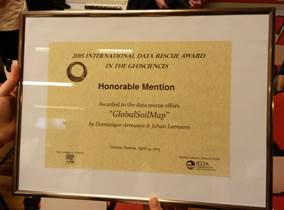Pedometrics News, May 2015
Pedometrics 2015 – Call for Abstract
We are very excited to invite you to Cordoba Spain, for Pedometrics 2015, September 15th-18th, 2015. The deadline of abstract submission is now by 30 May 2015.
This Conference incorporates meetings for the IUSS WG on Soil Landscape Modelling and Soil Monitoring. All aspects of Pedometrics will be covered, include: Soil-landscape modelling: mechanistic & empirical, Soil Morphometrics (image analysis, remote sensing, 3D soil imaging), Soil sampling and monitoring, Field experimental design, Digital soil mapping and proximal soil sensing, Bayesian statistics and Hierarchical Modelling in soils, Fuzzy cognitive mapping, Soil Spatial and Temporal Scaling, Soil Ecosystem Services, Big Data in Soil Science, and more.
More info at: https://sites.google.com/site/pedometrics2015/home or www.pedometrics.org
GlobalSoilMap got an Honourable Mention
GlobalSoilMap project was recently awarded an Honorable Mention by the 2015 International Data Rescue Award in Geosciences. Dominique Arrouays and Johan Leenaars submitted the application with many inputs from researchers around the world. Dominique the science coordinator of GlobaSoilMap, said that although we did not win he is pleased with a global recognition, and demonstrated that this project has gathered support from various institutions around the world and some good examples has been achieved.
Balanced Sampling for Soil Survey
Dick Brus, our soil sampling expert, recently proposed the use of Balanced Sampling for Soil Survey. Pedometricians usually optimized their sampling strategy to cover the geographical space, feature (covariate) space or both. Now Dick found that there is Balanced Smapling which is commonly used in socioeconomic study has not been noticed in soil science. It has several advantages, one of them is that Latin hypercube sampling is a special case of a balanced sampling. In addition, if balanced sampling is applied, the inclusion probabilities of the samples can be calculated and optimised. Thus samples obtained by this design can be used both in design-based or model-based statistical inference. Dick illustrated its application with examples in soil surveys. The paper is published online in the upcoming September issue of Geoderma.
Optimal spatial stratification using digital soil maps
Jaap de Gruijter and colleagues recently developed a new method to optimize spatial stratification and allocation for stratified random sampling of points. The method uses a grid of points with uncertain predictions of the target variable (for example a digital soil map). The objective function of the sampling stratification is defined by generalized distances between pairs of grid points, determined by the difference between the predictions, the variances of the prediction errors, and their covariance as a function of the geographical distance. The authors used an iterative reallocation algorithm to minimise this objective function. The resulting stratifications represent solutions on a continuous scale between two extremes: for errorless predictions, a stratification close to those by the cum-root-f method, and for entirely uninformative, a compact geographical stratification based only on the locations of the grid points. The authors illustrated it with a soil survey example. The study was published in the Journal of Survey Statistics and Methodology.
Equations that Changed the World
17 Equations that Changed the World is a book written by Ian Stewart in 2013. The author listed 17 most important mathematical equations that he thought have been a driving force behind nearly every aspect of our lives. Pedometricians have frequently used at least 8 of the equations in their works (can you recognise them?). Let me know if you think there are Equations that Changed Soil Science or maybe equations that defined Pedometrics.
Pedometrics 2017
Pedometrics will be celebrating its Silver Jubilee in 2017. The first pedometrics conference was held in Wageningen in September 1992. Planning for Pedometrics 2017 is underway to celebrate 25th anniversary at its birthplace. Gerard Heuvelink will be organising the conference from 26 June to 2 July 2017 at Hof van Wageningen which is the same location used in 1992! This will also be a joint conference with four of its Working Groups:
- Digital Soil Mapping
- Proximal Soil Sensing
- Soil Monitoring
- Modelling of Soil and Landscape Evolution
Mark on your calendar now for this once in a lifetime important event!
Upcoming Meetings
Global Soil Security Symposium, Texas A&M University, College Station, Texas, May 19-21 2015.https://globalsoilsecurity.tamu.edu/index.html
The 4th Global Workshop on Proximal Soil Sensing, Sensing Soil Conditions and Functions, Hang Zhou, China, May 12-15 2015. http://www.gwpss2015.com/
Global Workshop on Digital Soil Morphometrics, University of Wisconsin, Madison, June 1-4, 2015.http://digitalsoilmorphometrics.org/


